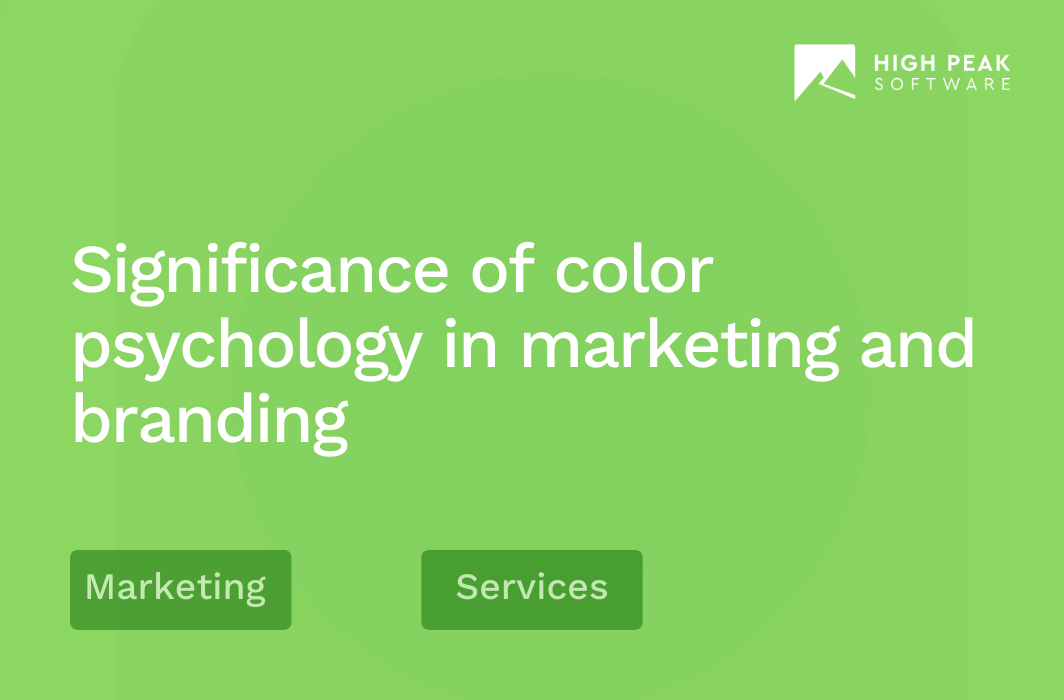Significance of color psychology in marketing and branding
Ayaan Bhattacharjee
Content Writer

Table of Contents
- What is color psychology?
- How do entrepreneurs use color psychology in marketing?
- Why does color psychology matter in marketing?
- How to use color psychology to improve your marketing?
- Choose High Peak and enhance your branding and marketing
Color psychology plays an essential role in how we perceive brands and react to their marketing strategies. The use of color psychology in marketing isn’t merely aesthetic but goes deeper, affecting our emotions and decisions. Similarly, colors in branding psychology can significantly shape brand identity, translating a brand’s values into visual language.
Therefore, comprehending color in branding psychology can pave the way for more effective branding strategies. In this blog, we will delve deeper into the intriguing world of color psychology, focusing on its application in marketing and branding. Gain insights into how colors can drive consumer behavior and brand perception.
What is color psychology?
Color psychology is the study of how colors influence human behavior and decision-making processes. It examines our emotional and psychological responses to specific colors and how these responses can shape our actions. The psychology of colors in marketing is particularly true when it comes to making purchases or forming attitudes about products or brands.
Each color has unique psychological properties that are universally recognized or culturally specific, evoking certain feelings or reactions. For example, red is often associated with excitement or urgency, while blue conveys trust and reliability.
In marketing and branding, color in branding psychology is applied to enhance customer engagement and influence purchasing decisions. Businesses strategically choose colors in their logos, advertisements, and products in line with their brand values and the emotional response they want to induce. By grasping the core principles of color psychology in marketing, marketers and brand strategists can craft more impactful and compelling visual communication strategies.
How do entrepreneurs use color psychology in marketing?
Color psychology is a potent tool in an entrepreneur’s arsenal. It’s more than just picking attractive colors – it’s about strategic selection based on understanding consumer behavior and emotions evoked by different hues.
Let’s consider first impressions. When customers encounter a brand for the first time, color contributes to about 90% of their initial judgment. It means a rightly chosen palette can immediately draw customer attention, creating a positive influence that encourages further interaction with the brand.
Further, color can incredibly enhance brand awareness and memorability. It’s noted that smart color branding can improve recognition by up to 80%. Imagine global brands like Coca-Cola or McDonald’s – their specific color schemes are instantly recognizable even to a casual observer.
Lastly, it’s essential to remember that we live in a visual world. An overwhelming 93% of consumers consider visual appearance when they make purchasing decisions. Thus, adept application of color psychology in marketing can stimulate product appeal and persuade consumers to choose a product over its competitors.
In essence, entrepreneurs leverage the science of color psychology not only to create an engaging, visually appealing brand but also to sway consumers’ buying decisions, contributing significantly to business success.
Why does color psychology matter in marketing?
Understanding the influence of colors can shape a successful marketing strategy. Let’s explore why color in branding psychology holds such significance in marketing and how colors in marketing psychology can create a major impact on consumers.
Drives customer perception
Color is the first thing a customer registers when viewing a product, advertisement, or brand image. It sets the initial tone, influencing how a consumer feels about a product even before reading any text involved. Consequently, the color palette chosen can leverage the subconscious to establish positive or negative associations with a brand. Thus, color psychology in marketing influences customers’ perceptions right from their first interaction.
Defines brand identity
Every color has a unique psychological “personality.” Blue tends to imply trust and reliability, while yellow can evoke feelings of happiness and positivity. Marketers utilize these color associations while designing logos or brand themes. Therefore, color psychology in marketing enables marketers to communicate their brand identity and values subtly yet effectively, helping consumers understand what a brand stands for.
Affects conversion rates
Color psychology impacts the effectiveness of marketing components like call-to-action (CTA) buttons or promotional banners. For instance, red, a vibrant and urgent color, is often used for a CTA as it encourages immediate action. A well-planned color scheme, taking into account color psychology, can significantly affect the conversion rates by evoking the desired emotional responses leading to potential purchases.
Enhances brand recognition
Strategic use of colors can boost brand recognition by up to 80%. Consistent use of a signature color scheme across product packaging, websites, and marketing materials can make a brand immediately recognizable. Hence, using color psychology in marketing and improving its visibility and positioning in the market.
Influences purchasing decisions
Most buying decisions, particularly impulse purchases, are made with the heart and not the head. Color psychology in marketing plays a key role here, emotionally guiding consumers towards or away from purchases. For instance, cool colors like blue or green can enhance consumers’ perceived notion of product reliability, leading to a potential sale.
How to use color psychology to improve your marketing?
Color psychology plays a significant role in marketing, shaping how consumers perceive, engage with, and respond to a brand and its products. In order to harness color psychology effectively, there are several strategies that High Peak can help you with that marketers can employ:
Learn color psychology essentials
The first step to incorporating color psychology in marketing is understanding what colors symbolize and the emotions they can trigger. For instance, red can symbolize excitement or urgency, while blue often conveys trust and calmness. Colors in branding psychology also carry implications for specific industries. With a firm understanding of the essentials of colors in marketing psychology, most marketing tasks, from designing logos to creating ads, become more strategic and potentially more effective.
Start with emotion first
When choosing colors, it’s beneficial to start with the emotion you want your brand or product to evoke. Color psychology in marketing heavily relies on emotional reactions driven by different hues. For instance, do you want to convey urgency, tranquility, or perhaps optimism? Your answer will guide your choice of color.
Get inspired by other brands
Watching successful brands in your field can provide insight and spark creativity. You can discern their use of color psychology in marketing, understanding how they leverage specific colors in branding to forge meaningful connections with their audience. This active learning can inspire impactful color strategies in your own marketing endeavors.
Keep it consistent with your branding
Maintaining color consistency across all your branding elements helps enhance brand recognition, making your brand more memorable. Whether you’re designing a logo, social media post, or product package, color consistency is crucial in marketing.
Create a brand color palette
Creating a brand color palette enhances consistency throughout your marketing strategy. It streamlines your brand identity and promotes a cohesive message, improving the effectiveness of color psychology in your marketing efforts by shaping audience perception.
Keep cultural context in mind
While using color psychology in marketing, it’s essential to be mindful of cultural differences. Some colors might have different meanings in different cultures. When you address global audiences, consider colors in marketing psychology in relation to the target demographic’s cultural context.
Try to add some blue
Blue is often associated with dependability and truthfulness. Including some blue in your branding components might induce feelings of reliability in your audience. Thus, this step is important when you think colors in branding psychology.
Run color tests with your audience
Finally, run color tests with your audience. Different demographics react differently to various colors. Testing allows you to gauge their reaction, enabling you to optimize your strategy according to what works best, hence employing color psychology in marketing effectively.
Choose High Peak and enhance your branding and marketing
In conclusion, color psychology in marketing is a powerful tool that can influence perception, drive consumer behavior, and strengthen brand identity. Its essentials go far beyond aesthetics, curating emotional responses and potentially steering people towards desired actions. As you strategize your marketing plan, remember to incorporate this psychology essentials, draw inspiration from others, remain consistent in your branding, and consider your audience’s cultural context.
Through this understanding and application of color psychology, you can stamp your brand’s identity cohesively across multiple platforms. Thus curating a unique customer journey.
Let color psychology in marketing be your secret weapon for compelling branding and successful marketing campaigns. Book a call with High Peak, and get started with our experts.




